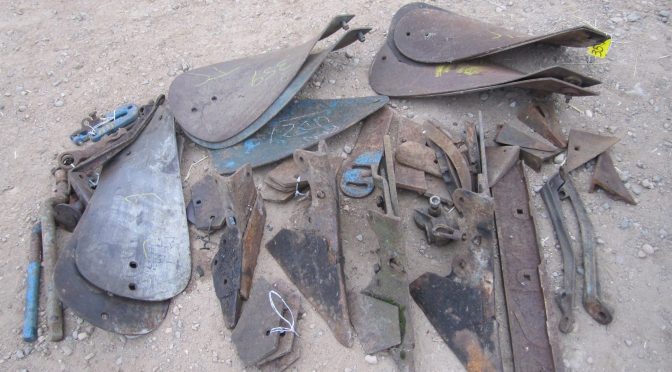Berwickshire was an important centre for the development of modern ploughs, i.e. iron ploughs. Their development in that county is described in the Board of Agriculture’s survey of agriculture of that county, published in 1809. It is worth quoting at length:
“The improved swing plough, having the beam secured by a chain, which carries back the draught almost to its body, with a curved mould board, and feathered sock, is almost usually used. This plough is believed to have come originally from Holland or Flanders into Yorkshire, where it is said to have been calculated the Dutch plough. On its first introduction into Scotland, it was known by the name of the Rotherham plough; and having been very materially improved by a plough wright from Berwickshire, named Small, it has long been very deservedly denominated from him “Small’s plough”.
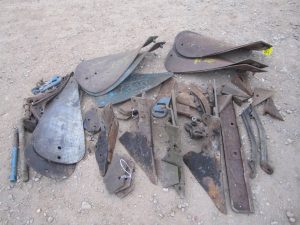 This is a very simple and efficient implement, of cheap construction, light draught, and easy management. Its chief excellence is in the structure of the mould board, which is of cast iron formed upon a uniform model. The peculiar form of this is of extremely difficult description, so as to be intelligible, being composed of several curves which soften into each other. At its fore part it is and exceedingly sharp wedge, so as to insinuate between the wasteland and the plit, to furrow slice, with the least possible resistance; the wedge gradually widens to separate the plot effectually, and it spreads out considerably wider upwards, so as to turn over the plit. In these operations it is assisted by the featured sock, which cuts out the bottom of the plit at such depth as may be regulated by the muzzle. The muzzle, or bridge of the plough, is so contrived that it may be set to work deeper or shallower, according to the nature of the soil and the pleasure of the ploughman, and to take broader or narrower plots according to cirumstances. All the surfaces which come in to contact with the soil are cast metal, or iron, by which the facility of draught is greatly promoted.
This is a very simple and efficient implement, of cheap construction, light draught, and easy management. Its chief excellence is in the structure of the mould board, which is of cast iron formed upon a uniform model. The peculiar form of this is of extremely difficult description, so as to be intelligible, being composed of several curves which soften into each other. At its fore part it is and exceedingly sharp wedge, so as to insinuate between the wasteland and the plit, to furrow slice, with the least possible resistance; the wedge gradually widens to separate the plot effectually, and it spreads out considerably wider upwards, so as to turn over the plit. In these operations it is assisted by the featured sock, which cuts out the bottom of the plit at such depth as may be regulated by the muzzle. The muzzle, or bridge of the plough, is so contrived that it may be set to work deeper or shallower, according to the nature of the soil and the pleasure of the ploughman, and to take broader or narrower plots according to cirumstances. All the surfaces which come in to contact with the soil are cast metal, or iron, by which the facility of draught is greatly promoted.
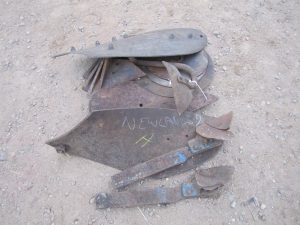 It may be proper to give a short account of the introduction of this singularly useful and economical implement into Berwickshire, from whence it has been adopted into all the well cultivated districts of Scotland, and many part soft the north of England. About the year 1764 very little was known in Berwickshire respecting the principles of construction of wheel carriages, and still less of the mechanical principles of the plough, good ploughs and carts being then purchased from Northumberland. At this period James Small, then a young and ingenipus mechanic, who had spent some time in England for iprovement, returned to Berwickshire, his native county. His merit becoming soon known to John renton, eww of Lumberton, a zealous promoter of agricultural implements, that gentleman settled Small at Blackadder Mount, erected all the necessary buildings for smith and carpenters shops for carrying on the manufacture of ploughs, carts, and wagons on a considerable scale, and set him agoing with the indispensable assistance of cash and credit. Small continued for many years at this place in full employment, often employing 20 or more carpenters, and six or eight blacksmiths, constructing ploughs, carts, wagons, and other implements of husbandry, both for this county and other parts of Scotland, his ploughs especially being much admired and sought after, and continue unrivalled to the present times, though now constructed by an infinite number of plough wrights in all parts of the country. Besides the plough, Small made material improvements on the construction of harrows, rollers, and fanners, or winnowing machines.
It may be proper to give a short account of the introduction of this singularly useful and economical implement into Berwickshire, from whence it has been adopted into all the well cultivated districts of Scotland, and many part soft the north of England. About the year 1764 very little was known in Berwickshire respecting the principles of construction of wheel carriages, and still less of the mechanical principles of the plough, good ploughs and carts being then purchased from Northumberland. At this period James Small, then a young and ingenipus mechanic, who had spent some time in England for iprovement, returned to Berwickshire, his native county. His merit becoming soon known to John renton, eww of Lumberton, a zealous promoter of agricultural implements, that gentleman settled Small at Blackadder Mount, erected all the necessary buildings for smith and carpenters shops for carrying on the manufacture of ploughs, carts, and wagons on a considerable scale, and set him agoing with the indispensable assistance of cash and credit. Small continued for many years at this place in full employment, often employing 20 or more carpenters, and six or eight blacksmiths, constructing ploughs, carts, wagons, and other implements of husbandry, both for this county and other parts of Scotland, his ploughs especially being much admired and sought after, and continue unrivalled to the present times, though now constructed by an infinite number of plough wrights in all parts of the country. Besides the plough, Small made material improvements on the construction of harrows, rollers, and fanners, or winnowing machines.
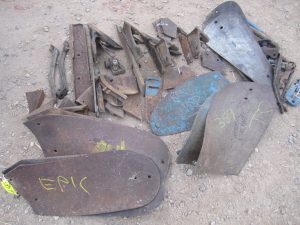 The old Scots plough, with a straight timber mould board, of greatly more obtuse angle, with a pointed sock, and having a long cumbrous bean. was partially used only a few days ago, but is hardly now to be seen anywhere. Even those that were used of late years, were very much reduced in size and weight. and had their beams much shortened, so as to fit them for the two horse draught. Some old farmers preferred that plough for breaking up old grass land, provincially lee, as it set the pits more upon edge yuan could be done conveniently by Smalls plough, especially when the pits or furrow slices were made broad. But by taking a plit of moderate breadth, about equal to its depth, Smalls plough answers equally well for this purpose, and is much superior for all other work. Perhaps for breaking up coarse land, much encumbered with the roots of whins and broom, and with large stones, the Scots plough may, in some respects, be more eligible than Small’s. But for this purpose, whatever plough is used ought to be of uncommonly strong construction, so as to be able to encounter severe hardships without breaking.
The old Scots plough, with a straight timber mould board, of greatly more obtuse angle, with a pointed sock, and having a long cumbrous bean. was partially used only a few days ago, but is hardly now to be seen anywhere. Even those that were used of late years, were very much reduced in size and weight. and had their beams much shortened, so as to fit them for the two horse draught. Some old farmers preferred that plough for breaking up old grass land, provincially lee, as it set the pits more upon edge yuan could be done conveniently by Smalls plough, especially when the pits or furrow slices were made broad. But by taking a plit of moderate breadth, about equal to its depth, Smalls plough answers equally well for this purpose, and is much superior for all other work. Perhaps for breaking up coarse land, much encumbered with the roots of whins and broom, and with large stones, the Scots plough may, in some respects, be more eligible than Small’s. But for this purpose, whatever plough is used ought to be of uncommonly strong construction, so as to be able to encounter severe hardships without breaking.
In ploughing very strong clay soils, the first furrow for fallow, three horses are sometimes put to the plough, but very rarely. In this case, two horse go arrest as usual, and the third is yoked in length before the furrow or off side horse. For this purpose the horse tree is made of unequal arms, so that the single horse has an advantage lever to enable him to draw against the other two, which pull at the shorter arm of the swinging beam, or horse tree.
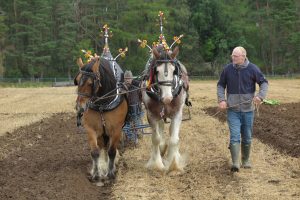 In driving the plough the ploughman, who of course walks between the two stilts, or plough handles, uses either whip reins, one to each horse on the opposite sides, or he has common long reins reaching to the stilts, and a single whip rein between the two horses. A driver is never to be seen with a plough throughout the whole county.
In driving the plough the ploughman, who of course walks between the two stilts, or plough handles, uses either whip reins, one to each horse on the opposite sides, or he has common long reins reaching to the stilts, and a single whip rein between the two horses. A driver is never to be seen with a plough throughout the whole county.
A plough having a mould board on each side, called the double mould board, is used for forming and splitting drills, and for earthing up rows of potatoes, turnips or beans. The construction of this plough is perfectly simple; and the mould boards are mere common deal boards, often fixed upon hinges so as to admit of being set wider or narrower, according to circumstances; and one of those boards, the near one side, is usually made to take off occasionally, for gathering the earth from the drills of potatoes, turnips, or beans, into the middle between the rows.
No trenching, draining, or road ploughs, nor any wheel ploughs, are at present used in this county. Many years ago the Norfolk wheel plough, and a Norfolk ploughman, were employed by the late Dr Hutton of Slighs-house, on the first introduction of the improved husbandry into Berwickshire; and were afterwards, both the plough and the individual labourer, used for some time by Mr Fordyce of Ayton. It was extremely impertinent to criticise an implement which the reporter has not seen at work, but he believes that it was not found universally applicable in grounds containing inequalities of surface, and numerous stones, both of which were apt to force it, by encountering the wheels, from its proper direction. Besides, he is apt to believe that the chief use of the wheels, in favourable soils, is to relieve the ploughman from attention and labour, by adding considerably to the draught of the horses.
The draining plough, or mole plough, was tried some years ago by Mr Fordyce of Ayton, and laid aside because, on the lands where he used it, there were so many stores under the surface, and so many tree roots, as to prevent it from answering the intended purpose. The reporter has seen very highly beneficial improvements from its use in Cambridgeshire; and has every reason to believe that it may one day become a most profitable implement in Berwickshire, more especially if used by means of a capstan, as now practised in some parts of England, by which the injury to the land, occasioned by the feet of the draught cattle, in the ordinary way, is entirely obviated.”
